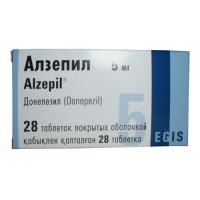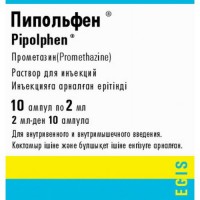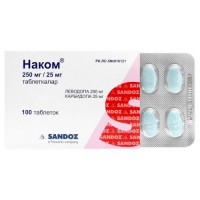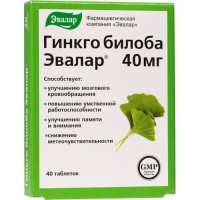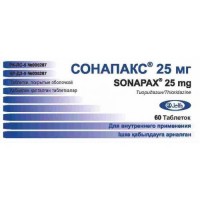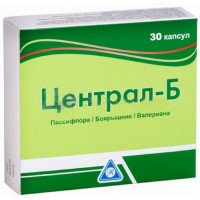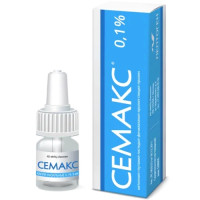Mirapex® ER (Pramipexole) 0.375 mg, 30 tablets
- $35.00
Sku:
2h65cax5ah
One tablet contains
Initial Therapy
The initial daily dose of 0.375 mg is gradually increased every 5-7 days. To reduce side effects, the dose must be adjusted to achieve the maximum therapeutic effect.
If it is necessary to further increase the daily dose, add 0.75 mg per week to a maximum dose of 4.5 mg per day. However, it should be noted that the incidence of symptoms of drowsiness increases with doses above 1.5 mg.
Patients taking Mirapex 0.25 mg and 1.0 mg tablets can be switched to Mirapex PV extended release tablets at the same daily dose. After switching to extended release tablets, the dose can be adjusted depending on the therapeutic effect.
Supportive care
The individual dose should be in the range of 0.375 mg to a maximum of 4.5 mg per day. When taking an initial daily dose of 1.5 mg, the drug is effective in the early and late stages of the disease. In clinical studies, in a separate group of patients, when taking a daily dose above 1.5 mg, an additional therapeutic positive effect is possible, especially at a late stage of the disease, when a reduction in the dose of levodopa is indicated. In combination therapy with levodopa, as the dose increases, as well as during maintenance therapy with pramipexole, it is recommended to reduce the dose of levodopa depending on the individual reactions of patients. This is necessary to avoid excessive dopaminergic stimulation.
Missed Dose
If the dose of Mirapex PV was missed at the usual time, then this dose should be taken within 12 hours after the usual time of admission. If more than 12 hours have passed, do not take this dose, take only the next dose at the scheduled time.
Termination of treatment
Abrupt discontinuation of dopaminergic therapy may lead to the development of neuroleptic malignant syndrome.
The accepted doses of the drug Mirapeks PV should be gradually reduced by 0.75 mg per day until the daily dose is 0.75 mg. Further, the dose should be reduced by 0.375 mg per day.
Doses for patients with renal insufficiency
Elimination of Mirapex PV from the body depends on renal function.
For initial therapy, patients with creatinine clearance above 50 ml / min do not need to reduce the daily dose or frequency of taking the drug.
With creatinine clearance in the range of 30-50 ml / min, treatment should be started with a dose of 0.375 mg every other day. Depending on the therapeutic efficacy and tolerability of Mirapex PV after a week of taking it, it is possible to increase the dose to a daily dose. If a further dose increase is necessary, the daily dose should be increased by 0.375 mg pramipexole at weekly intervals, up to a maximum dose of 2.25 mg pramipexole per day.
Treatment of patients with creatinine clearance less than 30 ml / min with Mirapex PV is not recommended, data are not available.
Doses for patients with hepatic insufficiency
There is no need to reduce the dose in patients with hepatic impairment.
Mode of application
Mirapex PV extended release tablets should be taken daily, once a day, at the same time, regardless of food intake. Tablets are taken orally whole, swallowed without chewing or breaking, washing down with water.
Adverse events are listed below using the following classification: very often ≥ 1/10, often ≥1/100 to <1/10, infrequently ≥1/1000 to <1/100, rarely ≥1/10000 to <1/1000, very rarely <10000, unknown - cannot be determined from the available data.
1 Adverse events observed in post-marketing surveillance.
Drowsiness
Pramipexole is often associated with drowsiness and infrequently with excessive daytime sleepiness and episodes of sudden falling asleep. Libido disorders
The drug Mirapeks PV can cause a violation of libido (decrease or increase).
Impulse control disorders
Craving for gambling (in the literature there are cases of pathological craving for gambling while taking pramipexole, especially at high doses, which stopped after discontinuation of the drug), increased libido, hypersexuality, obsessive desire to shop, compulsive overeating may occur in patients receiving agonists dopamine, including pramipexole.
Cardiovascular insufficiency
In clinical studies and post-marketing experience, cases of cardiovascular insufficiency have been reported in patients taking pramipexole.
The drug Mirapeks PV binds to plasma proteins to a small extent <20% and has a mild degree of biotransformation. The likelihood of drug interactions with other drugs that affect plasma protein binding or excretion by biotransformation is low.
Selegiline and levodopa do not affect the pharmacokinetics of pramipexole. Drugs that inhibit the active secretion of essential (cationic) drugs through the renal tubules. Cimetidine in combination with pramipexole reduces the renal clearance of the latter by 34%. Therefore, drugs that inhibit the active secretion of basic (cationic) drugs through the renal tubules or are eliminated in this way, such as cimetidine, amantadine, mexiletine, zidovudine, cisplatin, quinine and procainamide, when interacting with Mirapex PV, lead to a decrease in the clearance of one or both drugs. In order to avoid the development of signs of dopamine overstimulation (for example, dyskinesia, agitation or the appearance of hallucinations), it is necessary to reduce the dose when combined treatment with drugs of this type.
combination with levodopa. With an increase in the dose of Mirapex PV, a decrease in the dose of levodopa is recommended, the dose of other antiparkinsonian drugs must be maintained constant.
It is not recommended to take pramipexole simultaneously with antipsychotic drugs (see section "Special Instructions").
When prescribing the drug Mirapex PV to patients with renal insufficiency, it is recommended to reduce the dose in accordance with the section "Method of administration and doses".
Hallucinations and abnormal behavior are common side effects of dopamine agonist and levodopa treatment. Patients should be informed about the possibility of hallucinations (mainly visual).
Dyskinesia may occur during initial titration of Mirapex PV in combination treatment with levodopa in patients with advanced Parkinson's disease. If dyskinesia occurs, it is recommended to reduce the dose of levodopa.
Pramipexole may cause drowsiness and episodes of sudden sleep during daily activities, sometimes without awareness of what is happening or in the absence of warning signals, especially in patients with Parkinson's disease. Patients who have had episodes of drowsiness and/or episodes of sudden falling asleep should refrain from driving and operating machinery. This side effect may be prevented by dose reduction or discontinuation of treatment.
Because of possible additive effects, precautions must be taken when taking pramipexole and other sedatives or alcohol concomitantly.
Patients should be observed regularly for the development of an impulse control disorder . Patients and caregivers should be aware that in connection with treatment with dopaminergic drugs, symptoms of abnormal behavior may occur: impulse control and compulsive behavior disorders, such as compulsive overeating, compulsive shopping, increased libido, hypersexuality, pathological gambling, mania and delirium. In such cases, the dose should be reduced and treatment should be discontinued gradually.
Patients with psychiatric disorders should only use dopamine agonists if, given the benefit-risk ratio, the potential benefit outweighs the risk. The use of pramipexole and antipsychotics is not recommended, as antagonistic effects are possible.
Regular ophthalmological control is recommended , as well as when visual impairment is detected.
Caution must be exercised in case of severe cardiovascular pathology. It is recommended to monitor blood pressure, especially at the beginning of treatment, due to the general risk of orthostatic hypotension associated with dopaminergic therapy.
With abrupt discontinuation of dopaminergic therapy, symptoms suggestive of neuroleptic malignant syndrome have been observed.
Studies have shown that patients with Parkinson's disease have a high risk (2-6 times more often than other people) of developing melanoma, the developmental factors are unknown.
There have been reports of the presence in the stool of residues similar to intact tablets of Mirapex PV. When such reports are received from patients, the attending physician should re-evaluate the patient's response to therapy.
Pregnancy
The efficacy and safety of the drug during pregnancy and lactation in women have not been studied. During pregnancy, the drug should be prescribed only if the potential benefit to the mother outweighs the potential risk to the fetus.
lactation period
Excretion of the drug with breast milk has not been studied. Since pramipexole inhibits prolactin secretion, it can be assumed that it also inhibits lactation. Therefore, the drug should not be taken during breastfeeding. If the drug is necessary, breastfeeding should be discontinued.
Fertility
Studies on the effect of the drug on human fertility have not been conducted.
Features of the effect of the drug on the ability to drive a vehicle or potentially dangerous mechanisms.
Given the possible side effects from the nervous system (drowsiness, dyskinesia, dizziness) and psychiatric disorders (visual hallucinations) associated with taking the drug, patients should refrain from driving a vehicle or complex mechanisms. If patients experience excessive sleepiness or episodes of sudden sleep during daily activities (i.e. while talking, eating, etc.) at any time during treatment, they should refrain from driving or participating in potentially hazardous activities and seek medical attention.
Symptoms: Possible adverse events may be those related to the pharmacodynamic characteristics of the dopamine agonist, such as: nausea, vomiting, hyperkinesia, hallucinations, agitation and hypotension.
Treatment: no antidote. If signs of stimulation of the nervous system appear, antipsychotics may be recommended. Treatment of overdose along with gastric lavage, intravenous fluids, activated charcoal, and electrocardiogram monitoring may require routine supportive measures.
Store at a temperature not exceeding 25°C.
Keep out of the reach of children!
Shelf life - 3 years
Do not use the drug after the expiration date indicated on the package.
- active substance - pramipexole dihydrochloride monohydrate 0.375 mg
- excipients: hypromellose 2208, corn starch, carbomer 941, anhydrous colloidal silicon dioxide, magnesium stearate.
Indications for use
- treatment of symptoms of idiopathic Parkinson's disease (monotherapy or in combination with levodopa)
Dosage and administration
Initial Therapy
The initial daily dose of 0.375 mg is gradually increased every 5-7 days. To reduce side effects, the dose must be adjusted to achieve the maximum therapeutic effect.
| The scheme of increasing the dose of the drug Mirapeks PV | ||
| a week | extended release tablets (mg) | total daily dose (mg) |
| 1 | 0.375 | 0.375 |
| 2 | 0.75 | 0.75 |
| 3 | 1.50 | 1.50 |
If it is necessary to further increase the daily dose, add 0.75 mg per week to a maximum dose of 4.5 mg per day. However, it should be noted that the incidence of symptoms of drowsiness increases with doses above 1.5 mg.
Patients taking Mirapex 0.25 mg and 1.0 mg tablets can be switched to Mirapex PV extended release tablets at the same daily dose. After switching to extended release tablets, the dose can be adjusted depending on the therapeutic effect.
Supportive care
The individual dose should be in the range of 0.375 mg to a maximum of 4.5 mg per day. When taking an initial daily dose of 1.5 mg, the drug is effective in the early and late stages of the disease. In clinical studies, in a separate group of patients, when taking a daily dose above 1.5 mg, an additional therapeutic positive effect is possible, especially at a late stage of the disease, when a reduction in the dose of levodopa is indicated. In combination therapy with levodopa, as the dose increases, as well as during maintenance therapy with pramipexole, it is recommended to reduce the dose of levodopa depending on the individual reactions of patients. This is necessary to avoid excessive dopaminergic stimulation.
Missed Dose
If the dose of Mirapex PV was missed at the usual time, then this dose should be taken within 12 hours after the usual time of admission. If more than 12 hours have passed, do not take this dose, take only the next dose at the scheduled time.
Termination of treatment
Abrupt discontinuation of dopaminergic therapy may lead to the development of neuroleptic malignant syndrome.
The accepted doses of the drug Mirapeks PV should be gradually reduced by 0.75 mg per day until the daily dose is 0.75 mg. Further, the dose should be reduced by 0.375 mg per day.
Doses for patients with renal insufficiency
Elimination of Mirapex PV from the body depends on renal function.
For initial therapy, patients with creatinine clearance above 50 ml / min do not need to reduce the daily dose or frequency of taking the drug.
With creatinine clearance in the range of 30-50 ml / min, treatment should be started with a dose of 0.375 mg every other day. Depending on the therapeutic efficacy and tolerability of Mirapex PV after a week of taking it, it is possible to increase the dose to a daily dose. If a further dose increase is necessary, the daily dose should be increased by 0.375 mg pramipexole at weekly intervals, up to a maximum dose of 2.25 mg pramipexole per day.
Treatment of patients with creatinine clearance less than 30 ml / min with Mirapex PV is not recommended, data are not available.
Doses for patients with hepatic insufficiency
There is no need to reduce the dose in patients with hepatic impairment.
Mode of application
Mirapex PV extended release tablets should be taken daily, once a day, at the same time, regardless of food intake. Tablets are taken orally whole, swallowed without chewing or breaking, washing down with water.
Side effects
Adverse events are listed below using the following classification: very often ≥ 1/10, often ≥1/100 to <1/10, infrequently ≥1/1000 to <1/100, rarely ≥1/10000 to <1/1000, very rarely <10000, unknown - cannot be determined from the available data.
| Organ system/class | Often | Often | Infrequently | Rarely |
| Infections and infestations |
| |||
| endocrine disorders |
| |||
| Mental disorders |
|
|
| |
| Nervous System Disorders |
|
|
| |
| Visual disturbances |
| |||
| Cardiac disorders |
| |||
| Vascular disorders |
| |||
| Respiratory disorders |
| |||
| Gastrointestinal Disorders |
|
| ||
| Skin disorders |
| |||
| General violations and indicators |
|
|
1 Adverse events observed in post-marketing surveillance.
Drowsiness
Pramipexole is often associated with drowsiness and infrequently with excessive daytime sleepiness and episodes of sudden falling asleep. Libido disorders
The drug Mirapeks PV can cause a violation of libido (decrease or increase).
Impulse control disorders
Craving for gambling (in the literature there are cases of pathological craving for gambling while taking pramipexole, especially at high doses, which stopped after discontinuation of the drug), increased libido, hypersexuality, obsessive desire to shop, compulsive overeating may occur in patients receiving agonists dopamine, including pramipexole.
Cardiovascular insufficiency
In clinical studies and post-marketing experience, cases of cardiovascular insufficiency have been reported in patients taking pramipexole.
Contraindications
- hypersensitivity to pramipexole or to any component of the drug
- children's age up to 18 years
Drug Interactions
The drug Mirapeks PV binds to plasma proteins to a small extent <20% and has a mild degree of biotransformation. The likelihood of drug interactions with other drugs that affect plasma protein binding or excretion by biotransformation is low.
Selegiline and levodopa do not affect the pharmacokinetics of pramipexole. Drugs that inhibit the active secretion of essential (cationic) drugs through the renal tubules. Cimetidine in combination with pramipexole reduces the renal clearance of the latter by 34%. Therefore, drugs that inhibit the active secretion of basic (cationic) drugs through the renal tubules or are eliminated in this way, such as cimetidine, amantadine, mexiletine, zidovudine, cisplatin, quinine and procainamide, when interacting with Mirapex PV, lead to a decrease in the clearance of one or both drugs. In order to avoid the development of signs of dopamine overstimulation (for example, dyskinesia, agitation or the appearance of hallucinations), it is necessary to reduce the dose when combined treatment with drugs of this type.
combination with levodopa. With an increase in the dose of Mirapex PV, a decrease in the dose of levodopa is recommended, the dose of other antiparkinsonian drugs must be maintained constant.
It is not recommended to take pramipexole simultaneously with antipsychotic drugs (see section "Special Instructions").
Special instructions
When prescribing the drug Mirapex PV to patients with renal insufficiency, it is recommended to reduce the dose in accordance with the section "Method of administration and doses".
Hallucinations and abnormal behavior are common side effects of dopamine agonist and levodopa treatment. Patients should be informed about the possibility of hallucinations (mainly visual).
Dyskinesia may occur during initial titration of Mirapex PV in combination treatment with levodopa in patients with advanced Parkinson's disease. If dyskinesia occurs, it is recommended to reduce the dose of levodopa.
Pramipexole may cause drowsiness and episodes of sudden sleep during daily activities, sometimes without awareness of what is happening or in the absence of warning signals, especially in patients with Parkinson's disease. Patients who have had episodes of drowsiness and/or episodes of sudden falling asleep should refrain from driving and operating machinery. This side effect may be prevented by dose reduction or discontinuation of treatment.
Because of possible additive effects, precautions must be taken when taking pramipexole and other sedatives or alcohol concomitantly.
Patients should be observed regularly for the development of an impulse control disorder . Patients and caregivers should be aware that in connection with treatment with dopaminergic drugs, symptoms of abnormal behavior may occur: impulse control and compulsive behavior disorders, such as compulsive overeating, compulsive shopping, increased libido, hypersexuality, pathological gambling, mania and delirium. In such cases, the dose should be reduced and treatment should be discontinued gradually.
Patients with psychiatric disorders should only use dopamine agonists if, given the benefit-risk ratio, the potential benefit outweighs the risk. The use of pramipexole and antipsychotics is not recommended, as antagonistic effects are possible.
Regular ophthalmological control is recommended , as well as when visual impairment is detected.
Caution must be exercised in case of severe cardiovascular pathology. It is recommended to monitor blood pressure, especially at the beginning of treatment, due to the general risk of orthostatic hypotension associated with dopaminergic therapy.
With abrupt discontinuation of dopaminergic therapy, symptoms suggestive of neuroleptic malignant syndrome have been observed.
Studies have shown that patients with Parkinson's disease have a high risk (2-6 times more often than other people) of developing melanoma, the developmental factors are unknown.
There have been reports of the presence in the stool of residues similar to intact tablets of Mirapex PV. When such reports are received from patients, the attending physician should re-evaluate the patient's response to therapy.
Pregnancy
The efficacy and safety of the drug during pregnancy and lactation in women have not been studied. During pregnancy, the drug should be prescribed only if the potential benefit to the mother outweighs the potential risk to the fetus.
lactation period
Excretion of the drug with breast milk has not been studied. Since pramipexole inhibits prolactin secretion, it can be assumed that it also inhibits lactation. Therefore, the drug should not be taken during breastfeeding. If the drug is necessary, breastfeeding should be discontinued.
Fertility
Studies on the effect of the drug on human fertility have not been conducted.
Features of the effect of the drug on the ability to drive a vehicle or potentially dangerous mechanisms.
Given the possible side effects from the nervous system (drowsiness, dyskinesia, dizziness) and psychiatric disorders (visual hallucinations) associated with taking the drug, patients should refrain from driving a vehicle or complex mechanisms. If patients experience excessive sleepiness or episodes of sudden sleep during daily activities (i.e. while talking, eating, etc.) at any time during treatment, they should refrain from driving or participating in potentially hazardous activities and seek medical attention.
Overdose
Symptoms: Possible adverse events may be those related to the pharmacodynamic characteristics of the dopamine agonist, such as: nausea, vomiting, hyperkinesia, hallucinations, agitation and hypotension.
Treatment: no antidote. If signs of stimulation of the nervous system appear, antipsychotics may be recommended. Treatment of overdose along with gastric lavage, intravenous fluids, activated charcoal, and electrocardiogram monitoring may require routine supportive measures.
Storage conditions
Store at a temperature not exceeding 25°C.
Keep out of the reach of children!
Shelf life - 3 years
Do not use the drug after the expiration date indicated on the package.

